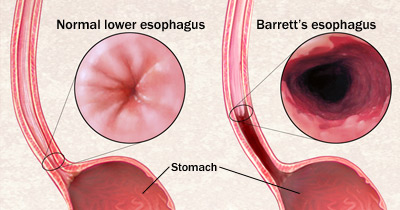
The oesophagus is the muscular tube or gullet that connects the oral cavity to the stomach. Food passes through the oesophagus, which is normally lined in the inner wall by flat cells. People who have a condition called Barrett's oesophagus (also spelled Barrett’s esophagus) have abnormal cells lining in the lower gullet, and an increased likelihood of developing cancer in the oesophagus. If you have Barrett’s oesophagus, consult a doctor to determine if precancerous changes are developing in your oesophagus. If so, you may be advised to seek treatment to reduce your risk of cancer.
What Is Barrett's Oesophagus?
Barrett's esophagus (named after the person who first discovered it) is a condition that affects the lower esophagus. The esophagus (or oesophagus) is the gullet or muscular tube that is lined inside with pinkish-white squamous cells. These cells are characteristically flat. However, people who have Barrett's oesophagus develop cells that are tall (columnar) and red. These columnar cells develop in the lower end of the esophagus near the stomach, which is normally lined with similar cells. Therefore, the condition is sometimes also called columnar-lined oesophagus.
What Are the Symptoms of Barrett's Oesophagus?
Some people who have Barrett's oesophagus do not experience any symptoms at all. The condition may be found only during examination for other medical conditions.
Common symptoms of Barrett’s esophagus include indigestionand heartburn. You may also experience difficulty swallowing food, nausea and vomiting. Less commonly, you may have blood in your vomit or pain when swallowing. Seek medical help if your symptoms do not improve in two weeks, or if you see blood in your vomit.
What Causes Barrett's Oesophagus?
Most often, Barrett's oesophagus is caused bygastroesophageal reflux disease, which is also called reflux esophagitis. This condition occurs when stomach acids irritate your esophagus. While your stomach is lined by cells that are resistant to acidic environment, the esophagus is not. So, when acid goes up into the lower esophagus, inflammation can take place.
However, not everyone who has GERD will develop Barrett’s oesophagus. Only about 10% of people with recurring or chronic reflux esophagitis will develop Barrett's oesophagus after many years. And Barrett's esophagus is more likely to occur in people who are over 50, and is more common in men. If you have symptoms of acid reflux (even though which could be mile) and you smoke or overweight, then you have a higher risk to develop Barrett's oesophagus than others.
What Can I Do to Relieve Symptoms of Barrett's Oesophagus?
In most cases, Barrett’s oesophagus is not a serious disease. However, you can relieve most of its symptoms by making lifestyle changes and avoiding things that could result in acid reflux.
1. Make Dietary Changes
If you have GORD, you may be advised to make some dietary changes to improve your symptoms. These include eating frequent small meals instead of three big meals and eating less fatty foods. You must also avoid foods or drinks that can make your symptoms worse, such as:
- Greasy foods
- Spicy foods
- Tomatoes/tomato products
- Peppermint
- Chocolate
- Coffee
- Alcoholic drinks
2. Change Your Lifestyle
Make some lifestyle changes to reduce symptoms of GORD, which are associated with Barrett's esophagus. These include the following steps:
- Maintain a healthy weight.
- Avoid wearing tightfitting clothes that can press on your abdomen and increase acid reflux.
- Stop smoking.
- Avoid bending orstooping, especially right after eating.
- Avoid lying down after meals. Wait for at least three hours after meals before going to bed.
- Raise the head of your bed about 6 to 8 inches by using wooden blocks.
What Are the Medical Treatments for Barrett's Oesophagus?
If your symptoms do not improve after trying home remedies, consult a doctor for further evaluation and treatment. Medical treatment for Barrett’s oesophagus usually includes the following measures:
1. First Reduce Acid Reflux
Medical treatment is aimed at preventing or slowing the development of Barrett's oesophagus by controlling acid reflux. Medications include:
- Proton pump inhibitors to reduce the production of acid in your stomach
- Antacids to counteract stomach acidity
- H2 blockers to reduce the release of acids in the stomach
- Pro-motility drugs to speed up emptying of the stomach
2. Repair a Hernia
Surgical repair of a hiatus hernia may help reduce acid reflux. If the hiatus hernia affects the chest area, chest surgery may be necessary.
3. Strengthen the Valve of the Oesophagus
To strengthen the lower esophageal valve, a surgical procedure called fundoplication may be done. In this procedure, the surgeon may make a small incision on the abdomen and operate using a laparoscope. Another alternative is to operate through a large incision (laparotomy). The surgery results in reduction of acid reflux.
4. Remove the Affected Area
Another way to treat Barrett’s esophagus is to remove abnormal tissues, which may be done in different ways, such as:
- Photodynamic therapy (PDT). This treatment uses an endoscope to insert laser light into the esophagus to destroy abnormal cells without damaging normal tissues. To make the abnormal cells light-sensitive, the patient is asked to take a drug called Photofrin.
- Endoscopic mucosal resection (EMR). This procedure removes the abnormal tissues lining the esophagus through an endoscope. It aims at removing precancerous or cancerous cells in the esophageal lining. If there are cancer cells, an ultrasound is done before the procedure to determine if deeper tissues of the esophagus are involved.
- Surgery. Severe changes (dysplasia) or cancer of the esophagus is removed early to increase your chance of being cured.
- Epithelial radiofrequency ablation (EFA). This procedure involves the insertion of a radiofrequency energy coil through endoscopy. The coil emits heat energy and destroys abnormal cells, which are replaced by the multiplication of adjacent normal cells.
- Argon plasma coagulation. Abnormal cells are destroyed by using a stream of argon gas and electric current.